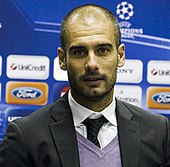Since its foundation the club has played with a crest. The club's original crest was a quartered diamond-shaped crest topped by the
Crown of Aragon and the
bat of King James, and surrounded by two branches, one of a laurel tree and the other a palm.
[114] In 1910 the club held a competition among its members to design a new crest. The winner was
Carles Comamala, who at the time played for the club. Comamala's suggestion became the crest that the club wears today, with some minor variations. The crest consists of the St George Cross in the upper-left corner with the Catalan flag beside it, and the team colours at the bottom.
[114]
The blue and red colours of the shirt were first worn in a match against Hispania in 1900.
[115] Several competing theories have been put forth for the blue and red design of the Barcelona shirt. The son of the first president,
Arthur Witty, claimed it was the idea of his father as the colours were the same as the
Merchant Taylor's School team. Another explanation, according to author Toni Strubell, is that the colours are from Robespierre's
First Republic. In Catalonia the common perception is that the colours were chosen by Joan Gamper and are those of his home team,
FC Basel.
[116]
Since its founding, Barcelona has never worn corporate advertisements on their shirt. On 14 July 2006, the club announced a five year agreement with
UNICEF, which includes having the UNICEF logo on their shirts. The agreement has the club donate €1.5 million per year to UNICEF (0.7 percent of its ordinary income, equal to the UN International Aid Target,
cf. ODA) via the FC Barcelona Foundation.
[117] The FC Barcelona Foundation is an entity set up in 1994 on the suggestion of then-chairman of the Economical-Statutory Committee, Jaime Gil-Aluja. The idea was to set up a foundation that could attract financial sponsorships to support a non-profit sport company.
[118] In 2004, a company could become one of 25 "Honorary members" by contributing between £40,000–60,000 (£45,800–68,700)
[119]per year. There are also 48 associate memberships available for an annual fee of £14,000 (£16,000)
[119] and an unlimited number of "patronages" for the cost of £4,000 per year (£4,600).
[119] It is unclear whether the honorary members have any formal say in club policy, but according to the author Anthony King, it is "unlikely that Honorary Membership would not involve at least some informal influence over the club".
[120]







